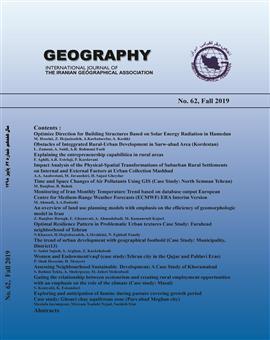Studying perception of 20th district of Tehran from features of Islamic urban area
Subject Areas :ماندانا حبیبی 1 , Hosein Mojtabazadeh 2
1 -
2 -
Keywords: Islamic city, Physical, Perception, Islamic Identity, Tehran.,
Abstract :
From the beginning of the formation of the Islamic government, this religious school has always emphasized in the sacred books and the narrations of its elders about respect for Muslim communities and the necessity of communication between them. The outstanding manifestation of these concepts has emerged in the cities of the early centuries of Islam. This has led the Islamic city as a space for the development of other Islamic fundamental principles and principles. However, with the emergence of modern thinking and the emergence of numerous movements, we see that many of these concepts have been met with considerable damage. This is considerably more significant in neighborhoods with a rich historical, religious, and civilian background, and its inhabitants can face the challenges of identity. The 20th district of Tehran is also one of the most valuable areas for this study, with the aim of measuring the readings of its inhabitants from the perspective of the Islamic city. Following the extraction of indices and sub-indexes related to the Islamic city from the opinions of experts and the conceptual modeling of the research, using the design and distribution of 50 questionnaires in the spectrum of 5 likert options, the characteristic The findings of the Islamic city were derived from the perceptions of the inhabitants of the 20th area using inferential statistics. The results of the findings suggest the fact that from the viewpoint of citizens, the most vulnerable factors that led to the deterioration of the quality of the 20th district of Tehran from the Islamic point of view were physical and environmental factors, and social and value factors are at a later stage. have.
- سدی محل چالی، مسعود (1394) فراتر از شهرسازی، آنچه برنامهریزان و طراحان ایرانی باید بدانند، انتشارات آرمانشهر.
- اعتضادي لادن، (1378)، نقش مسجد در ساختار شهرهاي مسلمان نشین، ش 44، ماهنامه مسجد
- بحرینی، سیدمحسن، از شار تـا شـهر، انتشـارات دانشـگاه تهـران، تهران، .1387
- پاکزاد، جهانشاه (1390) تاریخ شهر و شهرنشینی در ایران، از آغاز تا دوران قاجار، انتشارات آرمانشهر، تهران.
- جابر، دانش (1390) مبانی شکل گیري و اصول سازمان یابی کالبد شهر اسلامی، مجله شهر ایرانی- اسلامی، سال اول، شماره یکم، پژوهشکده فرهنگ و هنر، تهران.
- حکیم، بسیم سلیم، شهرهای عربی - اسلامی: اصول شهرسازی و ساختمانی، ترجمه محمد حسین ملک احمدی و عارف اقوامی مقدم ،تهران، ازمان، چاپ و انتشارات وزارت فرهنگ و ارشاد اسلامی، 1381
- خدایی زهرا، تقوایی علی اکبر (1390) شخصیت شناسی شهر اسلامی با تاکید بر ابعاد کالبدي شهر اسلامی، فصلنامه علمی پژوهشی مطالعات شهر ایرانی اسلامی، شماره .4
- رضوی پور، مریم سادات و همکـاران، هویت ایرانی اسلامی شـهر تهران در گذر زمان، فصلنامه مطالعات ملی،؛ 51، سال سیزدهم، شـماره 3، .1391
- ستاري سار بانقلی، حسن (1390) اصول مدیریت شهري و شهر سازي رسول اکرم (ص) در مدینه النبی، مجله علمی پژوهشی معرفت، سال بیستم، شماره .171
- فکوهی، ناصر، انسانشناسی شهری؛ تهران: نشرنی؛ چاپ سوم ، 1385
- قالیباف، محمد باقر، پورموسـوی، سـید موسـی، شـهرهای جهـان اسلام و رویارویی با نوگرایی(مدرنیسم)، اطلاعات سیاسی- اقتصادی، شماره 237-238، .1390
- گودرزي سروش محمد مهدي، امین زاده گوهرریزي بهناز، نقی زاده محمد (1391) تجلی اندیشهي اسلامی در شهر با حضور مدرسه در محله، فصلنامه علمی- پژوهشی مطالعات شهر ایرانی- اسلامی، شماره .7
- نقره کار، رئیسی و عبدالحمید، محمدمنان، 1387. تحقیق پذیری هویت اسلامی در آثار اسلامی. علم و صنعت. ایران.
- نقی زاده ،محمد، تأثیر معماری و شـــهر بر ارزشـــ¬های فرهنگی،1385
- احمد, پوراحمد، موسوی، سیروس. (1389). ماهيت اجتماعي شهر اسلامي. مطالعات شهر ايراني اسلامي : زمستان 1389 , دوره 1 , شماره 2 ; از صفحه 1 تا صفحه 11 .
- زنگانه، احمد، 1392، زوال شهری، فرهنگ واژگان مخاطرات محیطی، جلد اول، قطب علمی تحلیل فضایی مخاطرات محیطی، جهاد دانشگاهی واحد خوارزمی، تهران.


